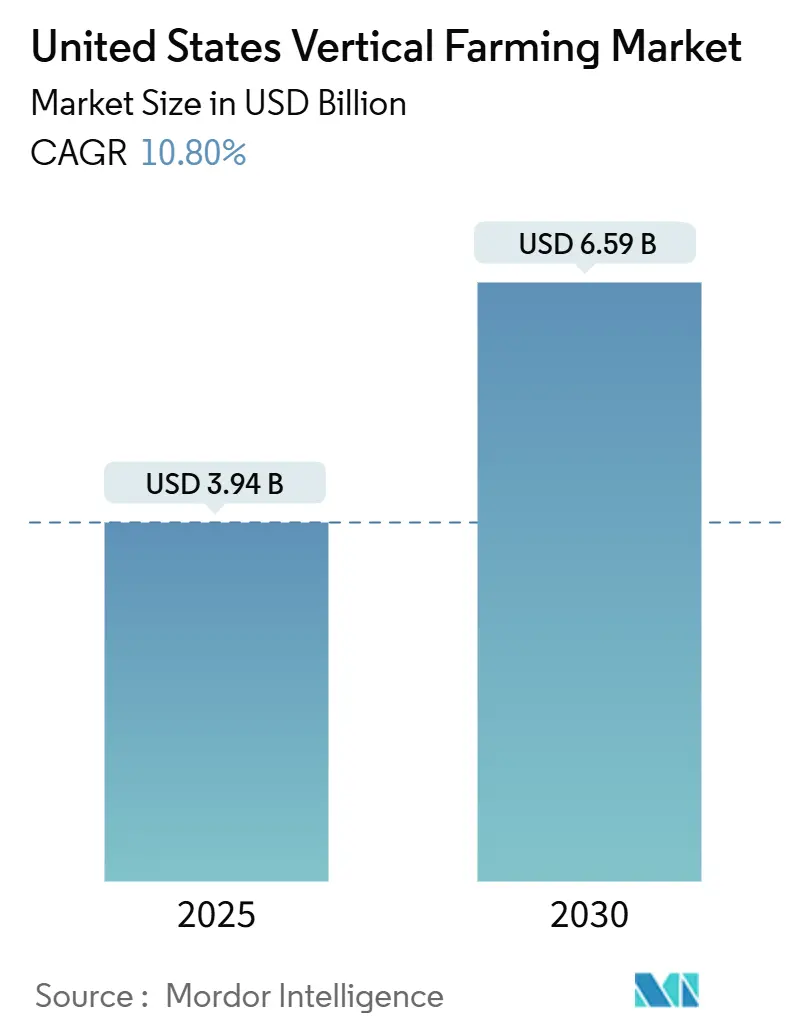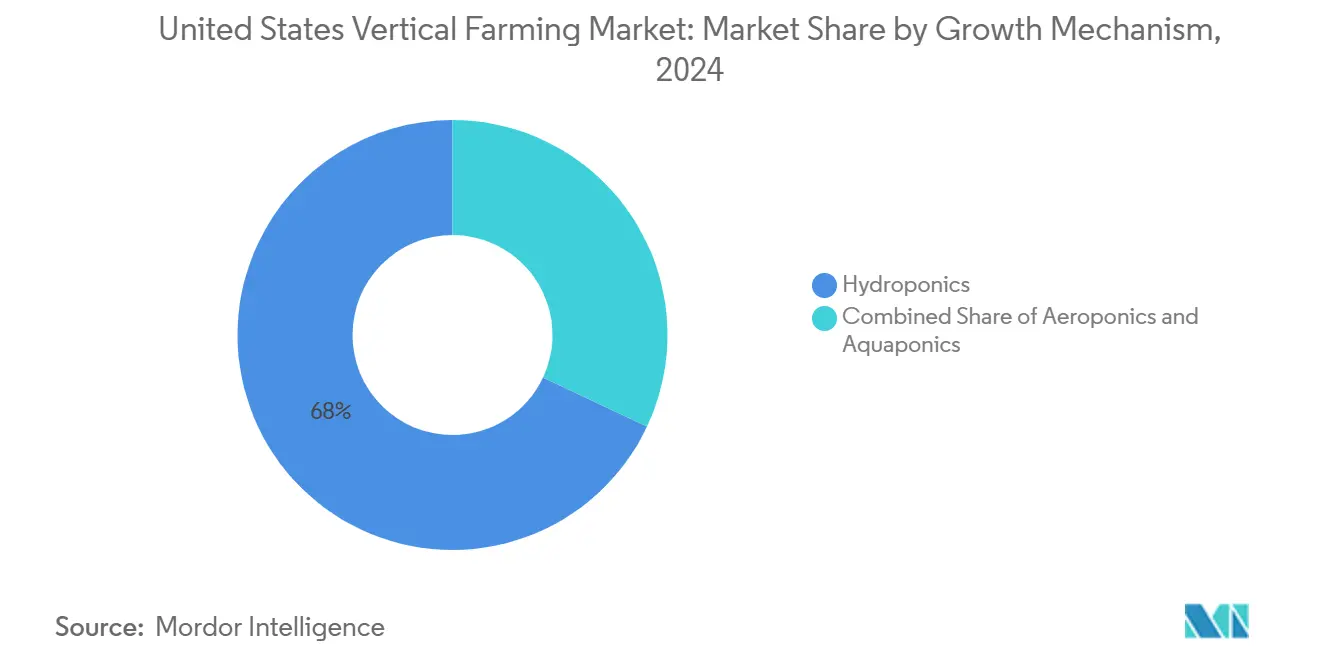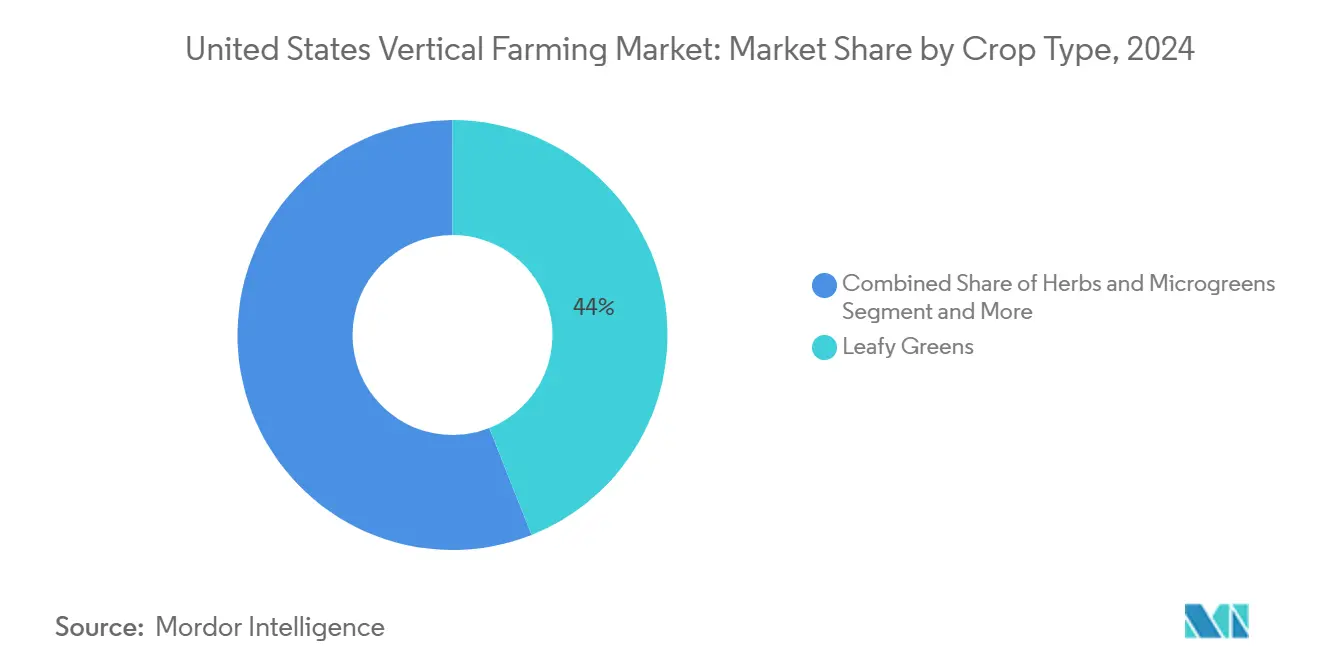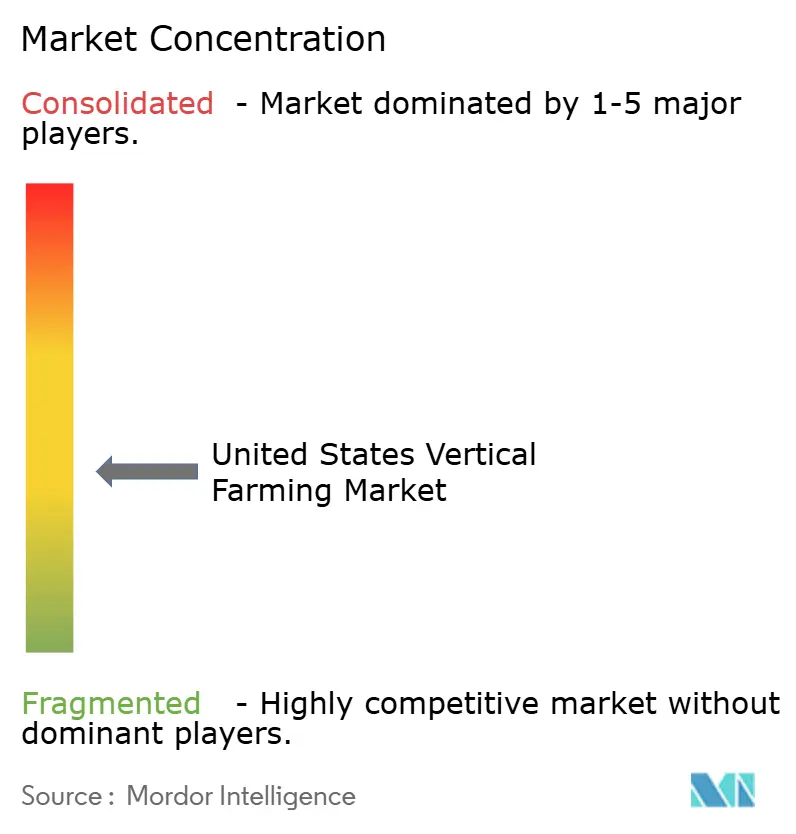
United States Vertical Farming Market Analysis by Mordor Intelligence
The United States vertical farming market reached USD 3.94 billion in 2025 and is forecast to grow at a 10.8% CAGR, hitting USD 6.59 billion by 2030. The expansion rate signals that industry growth now depends on technology-driven efficiency rather than aggressive capacity build-outs. Market consolidation during 2024 underscored this shift, with large, venture-backed operators unable to cover high operating costs despite substantial fundraising. Artificial-intelligence-enabled climate control, advanced LED lighting, and modular warehouse conversions are lowering energy use and shortening project timelines, giving disciplined players a cost advantage. Federal grants for urban agriculture, state-level drought regulations that favor water-frugal systems, and premium retail demand for pesticide-free produce together sustain a solid demand outlook. The competitive intensity remains moderate because the largest five firms hold less than half of the total revenue, allowing regional specialists to flourish.
Key Report Takeaways
- By growth mechanism, hydroponics led the United States vertical farming market with 68.0% of the market share in 2024, and aeroponics is projected to expand at a 18.4% CAGR through 2030.
- By structure, building-based facilities held 53.0% of the United States vertical farming market share in 2024, while warehouse conversions are projected to show the highest CAGR at 19.1% through 2030.
- By crop type, leafy greens accounted for a 44.0% share of the United States vertical farming market size in 2024, and berries are advancing at a 21.3% CAGR through 2030.
United States Vertical Farming Market Trends and Insights
Drivers Impact Analysis
| Driver | (~) % Impact on CAGR Forecast | Geographic Relevance | Impact Timeline |
|---|---|---|---|
| Rising demand for locally-grown pesticide-free produce | +2.1% | Northeast and West Coast urban centers | Medium term (2-4 years) |
| Urban focus on food-mile reduction and freshness | +1.8% | Chicago, New York, Los Angeles | Short term (≤ 2 years) |
| Water-efficient agriculture amid drought rules | +1.5% | California, Texas, Arizona | Long term (≥ 4 years) |
| Corporate and campus sustainability food mandates | +1.2% | Corporate clusters in tech hubs | Medium term (2-4 years) |
| Tax incentives and Opportunity-Zone financing | +0.9% | Designated inner-city zones | Long term (≥ 4 years) |
| AI-driven crop modeling lowers OPEX | +1.7% | Technology-advanced facilities nationwide | Short term (≤ 2 years) |
| Source: Mordor Intelligence | |||
Rising Demand for Locally-Grown Pesticide-Free Produce
Year-round, pesticide-free food now earns premium shelf prices, and sensory studies from the University of Copenhagen show taste parity with organic field crops, lifting consumer acceptance. Gotham Greens sells premium leafy greens through more than 850 Northeast supermarkets and maintains profitability by pairing local freshness with brand trust. Large grocers deepen supply contracts at 80 Acres Farms, for example, supplies 316 Midwestern stores, shipping 10 million servings annually. Corporate cafeterias echo retail momentum; AeroFarms renewed its Costco fresh-produce program in 2025.
Urban Focus on Food-Mile Reduction and Freshness
Cities now treat vertical farms as critical food security assets. Gotham Greens’ 210,000-square-foot Monroe, Georgia greenhouse places 90% of U.S. consumers within a one-day truck reach, strengthening cold-chain resilience. AutoStore and OnePointOne’s Arizona site delivers crops in 15 days from seed to shelf using high-density robotics. New York State approved a 385,000-square-foot “GigaFarm” that will output 8 million lb of produce yearly while operating at carbon-negative status.
Water-Efficient Agriculture Amid Drought Policies
California and neighboring states seek water cuts of up to 20% across irrigated acreage. Vertical farms using hydroponic recirculation cut water use by 90-97%, giving them a compliance edge under new mandates[1]Source: California Department of Food and Agriculture, “Drought Mandates for Agriculture,” cdfa.ca.gov. Plenty’s Richmond, Virginia, site achieves comparable strawberry yields while using 97% less land and 90% less water than field farms. USDA’s Rural Energy for America Program allocates clean-energy grants that allow these facilities to offset high electricity intensity with onsite solar arrays[2]Source: USDA, “Rural Energy for America Program,” usda.gov.
Corporate and Campus Sustainability Food Mandates
The growing focus on ESG (Environmental, Social, and Governance) targets among enterprises drives the adoption of long-term produce contracts, as companies seek to ensure sustainable and reliable agricultural supply chains. Local Bounti secured a multi-year contract with a global retailer in December 2024, highlighting the industry's shift toward stable, long-term partnerships. Academic institutions are also investing in agricultural technology advancement, as demonstrated by Penn State University's IoT crop-monitoring consortium receiving USDA funding to develop automated plant imaging systems. These imaging systems aim to enhance crop yield prediction and optimize resource utilization in agricultural operations.
Restraints Impact Analysis
| Restraint | (~) % Impact on CAGR Forecast | Geographic Relevance | Impact Timeline |
|---|---|---|---|
| High CAPEX and energy-intensive OPEX | -2.8% | High-utility states such as California and New York | Short term (≤ 2 years) |
| Economically viable crop range remains narrow | -1.9% | Nationwide | Medium term (2-4 years) |
| Electricity-price volatility hurts margins | -1.6% | Deregulated markets in Texas, Pennsylvania, Ohio | Short term (≤ 2 years) |
| Shortage of CEA-skilled workforce | -1.1% | Acute in rural areas and emerging urban regions | Long term (≥ 4 years) |
| Source: Mordor Intelligence | |||
High CAPEX and Energy-Intensive OPEX
A typical multilevel farm costs about USD 1,000 per ft² to build, and electricity accounts for up to 40% of monthly expenses. Bowery Farming and Plenty both filed for bankruptcy after raising more than USD 1.6 billion combined, underlining the risk when cost reductions lag scale-up. Dynamic lighting tied to wholesale power prices can trim bills by up to 18%. Operators such as Gotham Greens remain profitable by choosing low-cost power locations and standardizing designs across 13 facilities.
Economically Viable Crop Range Remains Narrow
Leafy greens generate USD 12.50 in revenue per plant site annually, while cereals produce lower margins under existing tariffs and energy costs. The significant margin difference between these crops influences cultivation decisions in vertical farming operations. Oishii's USD 150 million investment in premium strawberry production demonstrates that crop diversification is viable primarily in high-price market segments, where consumers are willing to pay more for quality and freshness.
Segment Analysis
By Growth Mechanism: Aeroponics Gains Despite Hydroponic Dominance
Hydroponics held 68.0% of the United States vertical farming market revenue in 2024, supported by mature supply chains and proven designs. Aeroponics, though representing a smaller base, will log an 18.4% CAGR to 2030 as 95% water-efficiency targets catch regulators’ attention in drought zones. The IoT nutrient sensors sharpen dosing accuracy across both systems, helping close the cost gap.
Precision imaging now notifies growers of nutrient stress within hours, further reducing waste. Operators, therefore, compete less on growth medium and more on integrated software that orchestrates lighting, fertigation, and harvesting.

Note: Segment shares of all individual segments available upon report purchase
By Structure: Warehouse Conversions Accelerate Growth
Building-based Vertical Farms retained 53.0% of 2024 revenue, but warehouse conversions will climb 19.1% annually as firms favor rapid deployment. The United States vertical farming market share of warehouse projects could exceed 45% by 2030. Conversions lower construction time by 30-40 weeks and cost 20-30% less than bespoke glasshouses. Freight Farms’ failure exposed limits of shipping containers yet did not derail broader warehouse interest, as 80 Acres Farms proves scale viability using repurposed logistics centers.
Modularity is pivotal, including rack-based grow towers being added in 10,000-ft² increments, aligning output with contract demand. Financing also improves because lenders prefer collateralized real estate over specialized steel and glass assets.
By Crop Type: Berry Premium Pricing Drives Diversification
Leafy greens comprised 44.0% of 2024 sales, but berries will post the highest 21.3% CAGR. Strawberries deliver retail prices of USD 4-5 per 8-oz pack, supporting energy costs that would crush commodity lettuce margins. Plenty’s Virginia site churns 4 million lb of strawberries yearly under controlled pollination, confirming commercial-scale economics.
Herbs and microgreens continue to service chefs and high-end grocers, preserving double-digit margins thanks to one-week grow cycles. Flowers remain niche, yet high-margin specialty orchids occupy slack rack space during lettuce crop rotations, optimizing revenue density.

Note: Segment shares of all individual segments available upon report purchase
Geography Analysis
The Southern United States maintains a dominance in the CEA market, primarily attributed to competitive electricity rates and strategically positioned distribution networks. Gotham Greens' state-of-the-art Georgia facility enables efficient 24-hour delivery to major Southeastern retailers, significantly minimizing product loss and transportation emissions. Virginia's formal recognition through the CEA Month declaration signals potential expansion of tax incentives for agricultural technology investments, while Hardee Fresh's substantial USD 56 million investment in Georgia underscores growing investor confidence in the region's CEA potential[3]Source: USDA, “Urban Agriculture Grants 2025,” usda.gov.
The Western region demonstrates impressive growth primarily driven by compelling water conservation advantages during persistent drought conditions. California's stringent environmental regulations and comprehensive renewable energy incentives support the widespread development of solar-powered facilities, enabling operators to effectively manage long-term energy costs. Arizona's successful implementation of automation technology validates the effectiveness of reducing labor dependencies in regions experiencing shortages of a skilled agricultural workforce.
The Northeast region strategically capitalizes on its proximity to concentrated, high-income consumer populations that consistently prioritize product freshness and quality. The significant real estate costs and elevated energy expenses create substantial barriers to rapid expansion. New York's innovative carbon-negative GigaFarm project demonstrates the feasibility of large-scale renewable energy integration in urban agriculture, while AeroFarms continues to strengthen its market presence through its strategic distribution partnership with Costco, ensuring consistent product availability to mass-market consumers.
Competitive Landscape
The United States vertical farming market arena remains moderately concentrated, leaving ample headroom for regional specialists and technology-first entrants. Gotham Greens exemplifies a resilient model built on standardized hydroponic units, disciplined site selection, and electricity costs held below 25% of sales, while Bowery Farming and Plenty both filed for bankruptcy despite raising more than USD 1.6 billion, proving that scale does not outweigh high fixed costs when efficiency lags. The resulting shake-out has lowered competitive clutter in premium leafy greens and redirected investor attention toward operators with clear pathways to profitability.
Technology capability, rather than acreage, now defines sustainable advantage. AI-driven climate control trims energy intensity by 25%, particle-swarm-optimized LEDs lift plant height by 55%, and autonomous harvesters cut labor hours in half, pushing first-pass yield close to 99%. Firms that master these tools widen margin gaps quickly because energy and payroll together exceed 60% of operating expenses for most peers. As a result, venture capital increasingly favors software-centric startups that license optimization platforms to multiple growers rather than betting on a single bricks-and-steel build-out.
Strategic moves center on vertical integration and channel lock-in. 80 Acres Farms acquired Mother Raw salad dressings to bundle produce with value-added condiments, raising average order value while deepening retailer relationships. Local Bounti secured a multi-year national contract by aligning output with a large retailer’s ESG targets, signaling that secure demand pipelines trump pure production scale. Meanwhile, USD 14.4 million in 2025 USDA urban agriculture grants lower entry barriers for niche crop specialists and software integrators, intensifying competition around berries, herbs, and farm-management analytics rather than commodity lettuce.
United States Vertical Farming Industry Leaders
-
Aero Farms
-
BrightFarms (Cox Enterprises)
-
Gotham Greens
-
80 Acres Farms
-
Local Bounti
- *Disclaimer: Major Players sorted in no particular order

Recent Industry Developments
- May 2025: Freight Farms filed for Chapter 7 bankruptcy, leaving container farm growers disconnected from technical support and spare parts supply, highlighting the risks of technology dependence in the vertical farming sector. The company's closure affects over 500 container farming units across the United States, demonstrating how supplier failures can disrupt distributed growing operations.
- October 2024: Artechno Growsystems and Gold Leaf Technologies partnered to launch FutureProp, a multi-layer precision propagation system utilizing Artechno's AVF+ vertical farming technology to enhance young plant production in North America. The partnership aims to maximize space efficiency and reduce labor costs in existing facilities.
- April 2024: Vertical Harvest, Inc., a hydroponic vertical farming company headquartered in Jackson, Wyoming, announced the completion of a USD 8.35 million Series A preferred stock investment. This funding is projected to support the company's expansion plans, enhance its technological capabilities, and strengthen its position in the United States vertical farming market.
- March 2024: 80 Acres Farms has acquired the Mother Raw premium salad dressing business from Reunion Foods Inc., a Toronto-based manufacturer that has been supplying 80 Acres Farms' salad kits with Mother Raw dressings.
United States Vertical Farming Market Report Scope
Vertical farming is the process of producing crops in layers that are vertically stacked. The crops are produced under a controlled environment, which maximizes plant development, and soilless farming techniques such as hydroponics, aquaponics, and aeroponics are frequently used.
The United States vertical farming market is segmented by growth mechanism (aeroponics, hydroponics, and aquaponics), structure (building-based and shipping container vertical farms), and crop type (fruits and vegetables, herbs and micro-greens, flowers and ornamentals, and other crop types). The report offers the market size and forecasts in terms of value (USD) for all the above segments.
| Aeroponics |
| Hydroponics |
| Aquaponics |
| Building-based Vertical Farms |
| Shipping-Container Farms |
| Warehouse-based Vertical Farms |
| Leafy Greens |
| Herbs and Microgreens |
| Fruits and Berries |
| Flowers and Ornamentals |
| By Growth Mechanism | Aeroponics |
| Hydroponics | |
| Aquaponics | |
| By Structure | Building-based Vertical Farms |
| Shipping-Container Farms | |
| Warehouse-based Vertical Farms | |
| By Crop Type | Leafy Greens |
| Herbs and Microgreens | |
| Fruits and Berries | |
| Flowers and Ornamentals |
Key Questions Answered in the Report
What is the current value of the United States vertical farming market?
The United States vertical farming market is valued at USD 3.94 billion in 2025 and is projected to reach USD 6.59 billion by 2030.
Which growth mechanism is expanding fastest?
Aeroponics will grow the quickest, posting an 18.4% CAGR through 2030 because it uses 95% less water than traditional farming.
What crop segment offers the best diversification opportunity?
Berries, especially strawberries, will grow at a 21.3% CAGR as premium pricing offsets higher production costs.
Why did several high-profile vertical farms file for bankruptcy?
Capital-intensive builds combined with volatile electricity costs outpaced revenue, highlighting that operational efficiency is more critical than scale alone.
Page last updated on:



